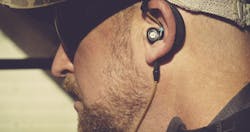Exposure to environmental noise is one of the leading causes of hearing loss. The excessive noise inherent on construction sites or in busy shops adds to the hazard, especially if the noise is constant.
Constant exposure wears down the delicate nerve hairs in the inner ear in the same way that toothbrush bristles wear down over time. And the damage is irreparable—once hearing is gone, it’s gone.
It sounds simple, but wearing good quality noise protection can prevent hearing loss.
If you are one of the 30 million workers exposed to hazardous levels of noise on the job, hearing loss is likely already happening. While you can’t always control the noise, you can control how you protect yourself.
Protective earbuds, plugs, or earmuffs that provide a Noise-Reduction Rating (NRR) of 20 or more can block out a significant percentage of damaging noise. To best understand what damaging noise is, let’s talk about decibels (dB), or one way that sound intensity is measured. On one end of the scale, 0 dB is barely audible sound. A normal conversation hovers around 55-65 dB.
From there, we move into the higher ranges: Highway traffic results in around 75 dB, and something as simple as a hairdryer accounts for 85 dB. A lawnmower garners 95dB; it’s around 130 dB for jackhammers and up to 140 dB for firearms or a jet engine. Construction sites often creep up over 100 dB on a regular basis.
To answer our original question on what’s too loud, if you are exposed to levels at or over 85 dB, particularly for a prolonged time or on a regular basis, you’re at a high risk of hearing loss.
Danny Libby, an audiologist from King of Prussia, Pa., recommends the use of audio lines that incorporate noise control technology. He says they offer a number of benefits to keep hearing safe.
“The ToughTested audio line incorporates noise-control technology,” Libby says. “There are a lot of earbuds on the market that claim noise isolation and noise control, but I was happy to see that this line actually carries an NRR of up to 26 dB, which means they took the matter seriously enough to actually go through the testing.
“Typically this level of scrutiny is associated with industrial and commercial products, not consumer ventures. This collection of earbuds can reduce the influence of environmental and background noise by up to 30 percent, has a microphone for hands-free communication, and each of the four models in the line is compatible with smartphones.”
The goal, of course, is to protect against hearing loss, tinnitus, and the daily stress of excessive noise by dampening loud vibrations before they can damage hearing. Earbuds are one way to block out a large amount of environmental noise, and using them allows you the wearer to keep music and conversations to safe, hearing-preserving levels.





